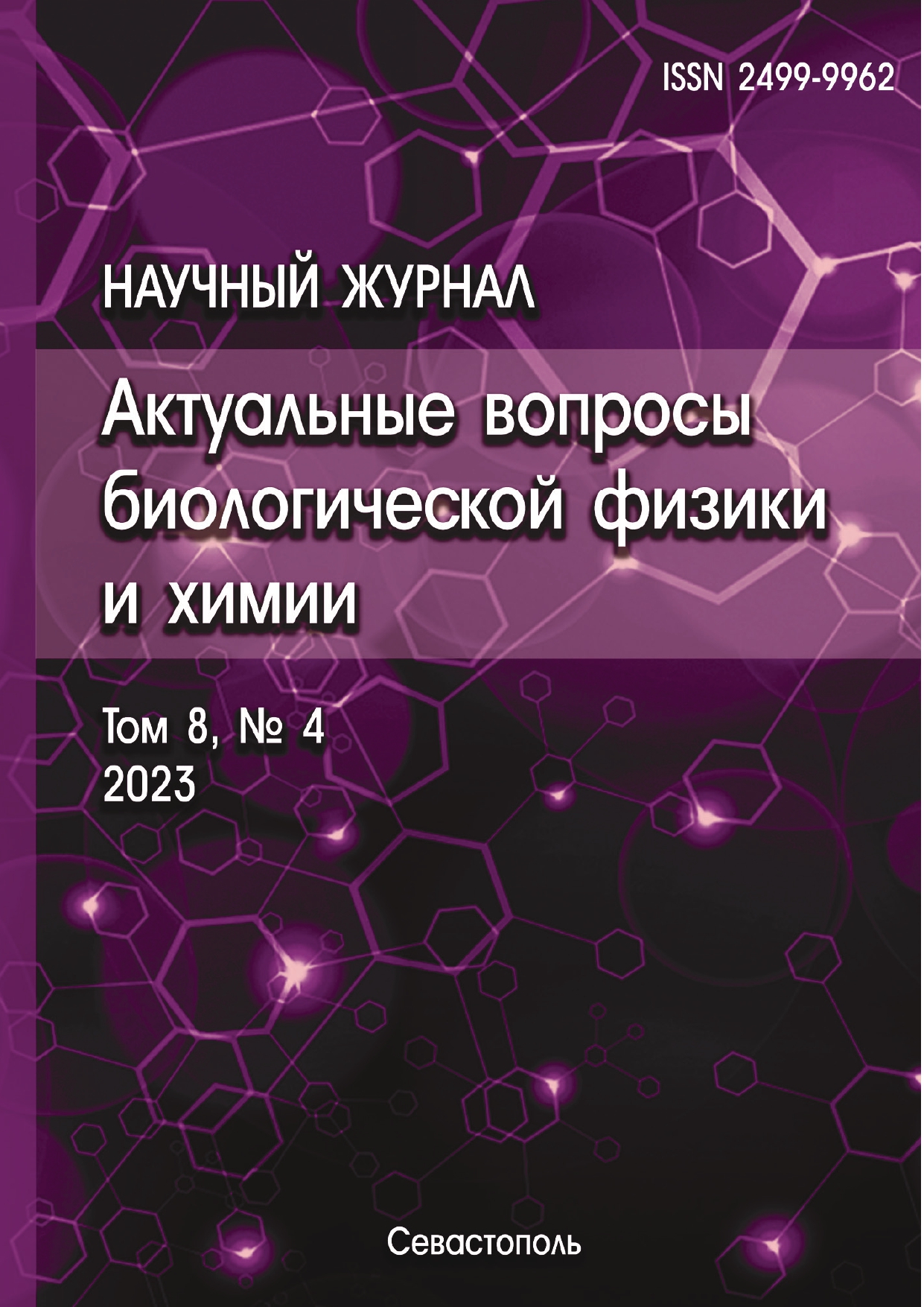Moscow, Moscow, Russian Federation
Moscow, Moscow, Russian Federation
Moscow, Moscow, Russian Federation
In this study, we analyzed the absorption spectra of the reaction products of aqueous extracts of mouse tissues with thiobarbituric acid, with the aim to determine the concentration of malonic dialdehyde (MDA) in them. The concentration of MDA is an important part of the analysis of the redox status of tissues, which is important in the study of inflammatory reactions, for example, after various stressful effects, as well as in the study of aging. In normal practice, they calculate the concentration of MDA in a solution by its optical density at 532 nm, then these data are related with similar solutions of the tetramethoxypropane (TMP) reaction with known concentration. We have shown that in cases of submicromolar MDA content, fluctuations in the nonspecific background level of the optical density of solutions can be commensurate to the magnitude of the actual absorption signal of the resulting colored adduct. Solutions of biological tissue extracts, due to the additional content of proteins, lipids and carbohydrates, are characterized by turbidity, which distorts the absorption spectrum non-linearly. The second derivatives of the absorption spectra deprived of background scattering distortions and can be used for automatic software calculation of the pigment content. Obtaining correct derivatives is complicated by the need to smooth the original spectra. We used two smoothing methods: the moving average method and the Savitsky–Goley filter with a polynomial of the third degree. We compared the data obtained on the basis of measuring the optical densities of solutions at 532 nm with those based on the analysis of the second derivatives of their absorption spectra, and also on the basis of integral sums of the second derivatives in the range of 520-550 nm. The results of calculations using the second derivatives gave 2-5 times lower concentrations of MDA than those obtained from optical densities at the maximum absorption of the adduct. At the same time, the convergence of the data, especially when using integral sums of the second derivatives, turned out to be significantly better than for the zero order, and the resulting errors were 2-3 times smaller.
derivative spectroscopy, smoothing of spectra, malondialdehyde (MDA), liver, lungs and brain of mice, oxidative stress
1. Pushkareva A.E. Methods of mathematical modeling in biotissue optics. Study guide. St. Petersburg: St. Petersburg State University ITMO, 2008, 103 p. (In Russ.). EDN: https://elibrary.ru/ZBCFWT
2. Bridge T.P., Fell A.F., Wardman R.H. Perspectives in derivative spectroscopy, Part 1-Theoretical principles. JSDS, 1987, vol. 103, no 1, pp.17-27, doi:https://doi.org/10.1111/j.1478-4408.1987.tb01081.x.
3. O'Haver, Thomas C. and T.H. Begley. Signal-to-noise ratio in higher order derivative spectrometry. Analytical Chemistry, 1981, vol. 53, pp. 1876-1878, doi:https://doi.org/10.1021/AC00235A036.
4. Sahini K., Nalini Dr.C.N. A review on derivative spectroscopy and its benefits in drug analysis. IJCRT, 2020, vol. 8, iss. 12, ISSN: 2320-2882.
5. Howard M., Workman Jr. Derivatives in Spectroscopy. Part II - The True Derivative. Spectroscopy, 2003, vol. 18, no. 9, p. 25.
6. Kostyuk A. I., Kotova D.A., Demidovich A.D. et al. Changes in key parameters of lipid metabolism in rat brain tissues during permanent ischemia. Bulletin of RSMU, 2019, vol. 1, pp. 50-57 (In Russ.). DOI: https://doi.org/10.24075/vrgmu.2019.008; EDN: https://elibrary.ru/PTJPMY
7. Ohkawa H., Ohishi N., Yagi K. Assay for lipid peroxides in animal tissues by thiobarbituric acid reaction. Anal. Biochem., 1979, vol. 95, no. 2, pp. 351-358.
8. Moselhy H.F., Reid R.G., Yousef S., Boyle S.P. A specific, accurate, and sensitive measure of total plasma malondialdehyde by HPLC. J. Lipid Res., 2013, vol. 54, pp. 852-858.
9. Domijan A.-M., Ralic J., Brkanac S.R., Rumora L., Zanic-Grubisic T. Quantification of malondialdehyde by HPLC-FL - application to various biological samples. Biomedical Chromatography, 2015, vol. 29, iss. 1, pp. 41-46.
10. Gulbahar O., Aricioglu A., Akmansu M., and Turkozer Z. Effects of Radiation on Protein Oxidation and Lipid Peroxidation in the Brain Tissue. Transplantation Proceedings, 2009, vol. 41, pp. 4394-4396.
11. Savitzky A., Golay M.J.E. Smoothing and differentiation of data by simplified least-squares procedures. Analytical Chemistry, 1964, vol. 36, no. 8, pp. 1627-1639.
12. Smith P.K., Krohn O.H., Hermanson G.T., Mallia A.K., Gartner F.H., Provenzano D., Fujimoto E.K., Goeke N.M., Olson B.J., Klenk D.C. Measurement of protein using bicinchoninic acid. Anal. Biochem., 1985, vol. 150, no. 1, pp. 76-85.
13. Zelzer S., Oberreither R., Bernecker C., Stelzer I., Truschnig-Wilders M., Fauler G. Measurement of total and free malondialdehyde by gas-chromatography mass spectrometry-comparison with high-performance liquid chromatography methology. Free Radic Res., 2013, vol. 47, no. 8, pp. 651-656, doi:https://doi.org/10.3109/10715762.2013.812205.
14. Ran Y., Wang R., Gao Q., Jia Q., Hasan M., Awan M.U., Tang B., Zhou R., Dong Y., Wang X., Li Q., Ma H., Deng Y., Qing H. Dragon's blood and its extracts attenuate radiation-induced oxidative stress in mice. J Radiat Res., 2014, vol. 55, no. 4, pp. 699-706.
15. Tsikas D., Rothmann S., Schneider J.Y., Suchy M.-T., Trettin A., Modun D., Stuke N., Maassen N., Frolich J.C. Development, validation and biomedical applications of stable-isotope dilution GC–MS and GC–MS/MS techniques for circulating malondialdehyde (MDA) after pentafluorobenzyl bromide derivatization: MDA as a biomarker of oxidative stress and its relation to 15(S)-8-iso-prostaglandin F2α and nitric oxide (NO). Journal of Chromatography B, 2016, vol. 1019, pp. 95-111.










